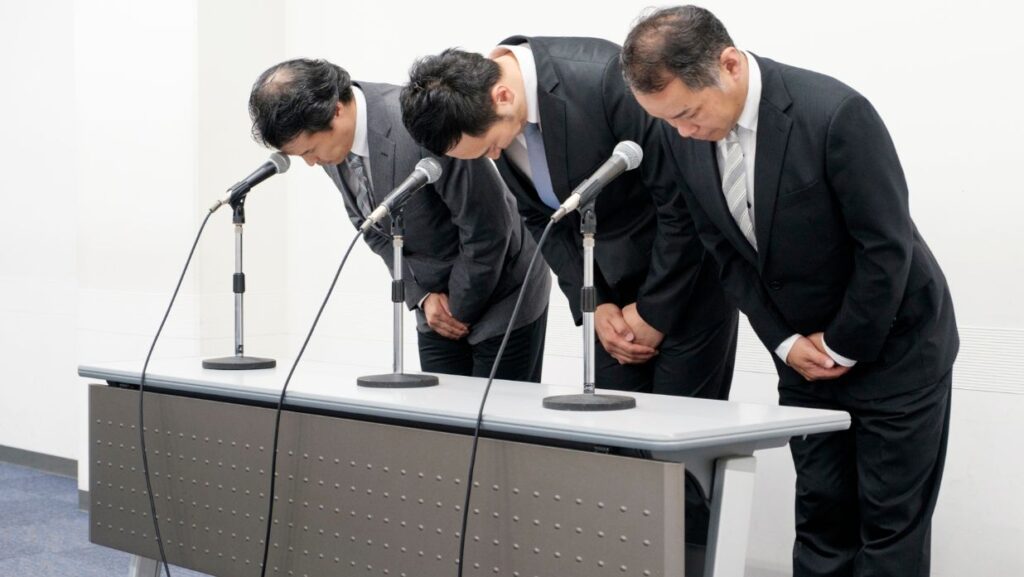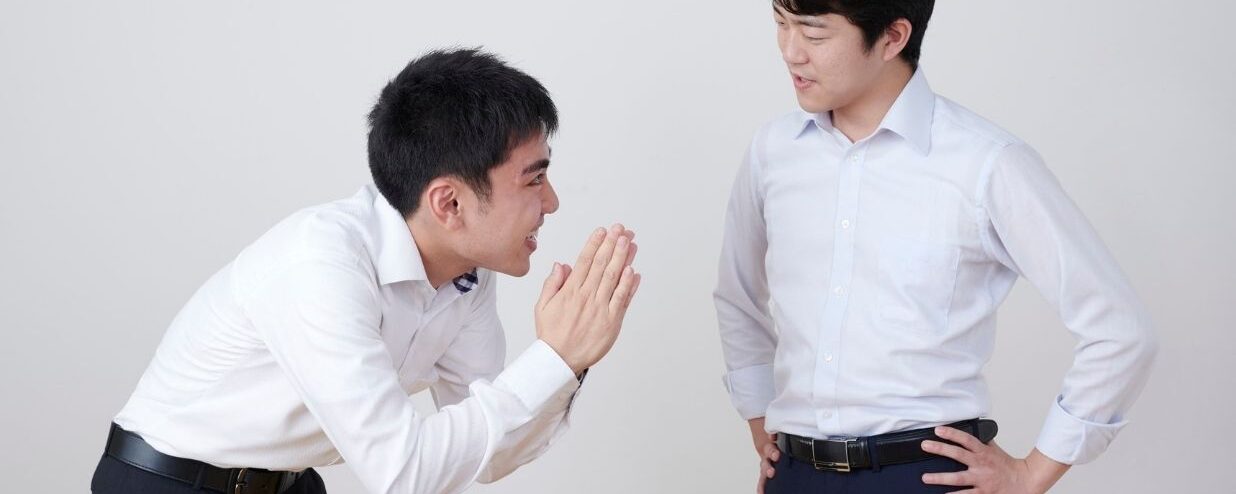Saying sorry in Japanese is often much more than simply apologizing. Once you start living here and having daily conversations, you’ll notice that phrases like sumimasen (すみません) appear in situations where — from a Western point of view — a simple “thank you” might seem more appropriate. For example, if you hold the elevator door open for someone, they might respond with sumimasen instead of arigatou. This can be confusing at first, especially if you’re unfamiliar with the cultural nuance behind the phrase.
“すみません!ありがとうございます。”
Sumimasen! Arigatou gozaimasu.
That is because in Japanese culture, apologies are not just about guilt — they’re a way to show humility, politeness, and consideration. And subsequently, there are many ways to say sorry, each with different levels of formality and subtle meaning. It’s good to understand the significance of each apology. In this article, we’ll look at the many ways to say sorry in Japanese, when to use each one, and how understanding these expressions can help you communicate more naturally and respectfully.
Before we proceed with the article, please note that it will utilize hiragana, so prior knowledge of this script is necessary. If you’re still learning them, don’t worry. Take a look at our hiragana chart to review them.
The Culture of Apologizing in Japanese Society
As you might know, Japanese people are known for their collectiveness and emphasis on harmony and coexisting with others. Individuals are expected to be mindful of how their actions affect those around them and to take responsibility accordingly. This mindset is deeply woven into daily life, from how people express gratitude and greet each other to how they navigate both personal and professional relationships.
Even if an individual is born with a unique set of personalities, in Japanese culture, the group comes before the individual. Because of this, harmony inside the group — which, in this case, is a society in general — should be maintained as much as possible.
In Japan, it’s expected to avoid causing meiwaku (迷惑), which means to trouble or annoy others, is one of the bases of Japanese politeness in public spaces. You can see it from small things, like people getting off their phone calls as soon as they go on public transport.
Being polite and courteous is the key to keeping social harmony intact in Japan. Along the way, people make “mistakes”.
Let’s revisit the elevator scenario. Why did the man say sumimasen instead of arigatou?
In Japanese, sumimasen isn’t just used to apologize — it also acknowledges that someone has gone out of their way for you. In this case, the man is essentially saying, “I’m sorry to have made you wait,” showing both apology and gratitude at the same time. That subtle mix of feelings is deeply rooted in Japanese communication.
In other words, it’s common for people in Japan to say sorry even for the smallest inconveniences. It’s a way of showing awareness of how your actions affect others — not just following social norms, but actively reflecting on them.
When Do I Need to Apologize in Japan?
1. When You Made a Mistake
This is obvious, but many of us might feign ignorance when we make a small mistake. It’s important to know that no matter how small, you need to give a genuine apology. Using respectful or humble Japanese form in particular when saying sorry, will come across as more intense.
2. When You’re Causing “Inconvenience”
When someone does a favor for you, like holding a door open and working an hour late to help you, it’s considered polite to “apologize” for causing an inconvenience.
3. When You Want to Show Appreciation
A lot of times, it’s acceptable — encouraged, even — to apologize to someone as a thankful gesture. It’s a way to show appreciation for someone who put thought and effort into you. Think of it like saying, “I’m sorry you have to go all this way for me.”
How to Apologize in Japanese: Everyday Use and Casual

When you accidentally step on your friend’s foot, we don’t expect you to do a full 90-degree bow and use very formal Japanese to apologize. It’s important to know that the Japanese language has several levels of formality, from casual to super polite. This all depends on who you’re talking to and the social context.
When you want to make a casual apology, we recommend using a casual Japanese form, or 丁寧語 (teinieigo). These versions of “I’m sorry” are more commonly used for everyday situations and small inconveniences.
For a deep dive into the difference between keigo (polite) and tameguchi (casual), head to our article here.
1. ごめんなさい (gomennasai): Sorry
The most common and straightforward way to apologize in Japanese comes in a lot of variations. Either way, be careful not to use it when you’re trying to apologize to your boss or superiors. While in English, there’s only one “sorry”, think of gomenasai as the most casual apology that translates directly to, well, sorry. If you want to add more sincerity, you can add the Japanese adverb 本当に:
本当にごめんなさい。
Hontou ni gomennasai.
I am so sorry.
私のせいで、ごめんなさい。
Watashi no sei de, gomennasai.
It was my fault, I’m sorry.
2. ごめんね (gomen ne): Sorry, man.
Now, this word is actually the shortened version of gomennasai, but you really need to use it with great caution. There’s a slightly playful and casual undertone when you use this. Depending on the situation too, it minimizes the intensity of your apology, so you shouldn’t use the phrase in a serious situation. You can say this when you bump on your friend or use their pen by mistake, but not when you accidentally kick a ball through your neighbor’s window.
ペン落としちゃった! ごめんね!
Pen otoshichatta! Gomen ne!
I dropped (your) pen! Sorry, man!
Note: In casual conversations among friends, Japanese people usually omit particles like を or は.
3. すみません (sumimasen): Excuse me
People usually rotate between sumimasen and gommenasai, so what’s the difference? ごめんなさい (gomennasai) is strictly used to apologize for something you did wrong. すみません (sumimasen) is used to apologize, too, but the word itself is so much more versatile. In fact, sumimasen can be used for non-apologetic situations, like telling someone you’re passing by or letting them go ahead first when entering a room.
すみません、後ろに通ります。
Sumimasen, ushiro ni toorimasu.
Excuse me, I’m passing from behind.
すみません、どうぞ。
Sumimasen, douzo.
Excuse me, go ahead.
So while すみません often seems interchangeable with ごめんなさい, the prior is a broader expression. In terms of nuance, gomennasai has a slightly more apologetic tone to it.
4. 悪い (warui): My bad
Similar to gomen ne that we discussed above, 悪い (warui) is another casual way to say sorry in Japanese. You’re not directly apologizing. Rather, you’re acknowledging you did something wrong, like saying “My bad!” in English.
You should only use warui to apologize to friends and peers for non-serious matters. Think of this as slang words between two very good friends.
悪い悪い!
Warui warui!
My bad!
Instead of saying warui na, you might also hear people say 悪い悪い (warui warui), which has the same meaning. Doubling the word adds a more casual, conversational feel, like quickly saying “Sorry, sorry!” in English.
Formal Ways to Say Sorry in Japanese

Stepping on your friend’s foot is one thing, but sending the wrong email draft to your Japanese boss is another thing. In this scenario, you want to express how deeply sorry you are. Saying sorry in Japanese humble form will help intensify your apology.
Remember that when you use these phrases in a casual context, you’ll come across as sounding stiff or, worse, trying too hard. Only save these apologies for moments where you really mess up badly.
1. 申し訳ございません (moushi wake gozaimasen): What I did was inexcusable.
申し訳ございません (moushi wake gozaimasen) is perhaps the humblest and most formal way to say sorry in Japan. Literally, 申し訳 (moushiwake) means “excuse” or “reason,” and ございません is the humble, polite form of “there is not.” So, when put together, it roughly translates to “There is no excuse.”
There are other variations of moushi wake gozaimasen, depending on the level of formality you’d like to achieve. For example, ございません is the most polite form of ありません, so you can replace it when you feel like using gozaimasen feels too stiff.
申訳わけありません。
Moushi wake arimasen.
Other variations include:
大変申訳わけありませんでした.
Taihen moushi wake arimasen deshita.
申し訳ない.
Moushi wake nai.
I’m sorry!
The word moushi wake nai is the same, but it’s a slightly more casual form than using ございません or ありません. You can use it when you’re trying to make a sincere (but still friendly) apology to your friends.
Unlike gomen nasai or warui, which are more casual apologies we discussed earlier, 申し訳ございません (moushiwake gozaimasen) is reserved for the most serious situations, often used in professional or formal settings. It expresses a deep sense of remorse and responsibility.
However, using this phrase for minor inconveniences—like accidentally bumping into a friend—can feel overly formal or excessive. In those cases, a lighter apology would be more appropriate.
2. ご迷惑をかけてすみません (gomeiwaku o kakete sumimasen): I’m sorry to have caused you trouble
The Japanese word meiwaku can be built into an apology phrase in the event you have created an issue or trouble with someone. In the business context, this means in the event that you’re causing the slightest inconvenience to the other party. This phrase means, “I am deeply sorry to have caused you trouble.”
ご迷惑をおかけして申し訳ございません。
Go meiwaku o okake shite moushi wake gozaimasen.
I’m sorry for the inconvenience.
The phrase above is a combination of ご迷惑 and 申し訳ございません, which further intensifies the apology. It is commonly used as a formal greeting in emails and announcements. Other variations include:
ご迷惑をかけてすみません。
Gomeiwaku o kakete sumimasen.
ご迷惑めいわくをかけてごめんなさい。
Gomeiwaku o kakete gomennasai.
3. 恐れ入ります (Osoreirimasu): I’m sorry
Similar to sumimasen, 恐れ入ります (Osoreirimasu) isn’t used as an actual apology, but as a way to excuse yourself. However, osoreirimasu is a more polite and formal way to say sumimasen.
Usually, the phrase 恐れ入ります (Osoreirimasu) is followed by another sentence, connected by が to show contrast.
恐れ入りますが、おかわりを頂けますか?
Osore irimasu ga, okawari o itadakemasuka?
Excuse me, but can I have another serving?
4. 謝罪いたします (shazai ita shimasu): I apologize
This is a formal way of apologizing. You’ll see politicians and celebrities saying this when they did something scandalous or needed to make a public apology. Sometimes, this is followed by a 90-degree bow.
5. ご面倒をお掛けして、すみません (gomendou o okakeshite, sumimasen): I’m sorry for the trouble
Similar to 迷惑, this variation of Japanese apology isn’t used when you’re actually begging for forgiveness. Instead, it’s a way to thank someone in Japanese for helping you. This is a formality when someone does something for you.
6. お詫び申し上げます (Owabi moushi agemasu): I apologize.
The word お詫び (owabi) means “I offer my deepest apologies.” This phrase is among the other things Japanese public figure says when they want to apologize to the public. Unlike 申訳わけありません (owabi moushi agemasu), お詫び申し上げます is a strictly formal form, and there’s no way to make it casual. It may even sound too stiff in conversations, so owabi moushi agemasu is mostly used in written language.
Fun fact: Owabi moushi agemasu is the chosen phrase used by Prime Minister Murayama in his infamous apology speech on behalf of Japan for their involvement in World War II.
There are alterations to change the level of humility owabi moushi agemasu. You can instead say:
お詫びいたします
Owabi ita shimasu.
I apologize.
7. 謝罪いたします (shazai itashimasu): I apologize
More commonly used in written form rather than speech, you should reserve this way of saying “I’m sorry” in Japanese for written statements in emails or letters to work, school or other formal recipients. It’s also quite a sincere apology.
The word shazai means ‘apology’, and itashimasu is the Japanese humble form of suru. This phrase translates to “I’m sorry for my actions.”
8. お許しください (o yurushi kudasai): Please forgive me.
If you’re already familiar with the Japanese language, kudasai is used to make a request. The apology using お許しください (o yurushi kudasai) literally means, Please forgive me in Japanese. Unlike casual apologies, o yurushi kudasai carries a tone of earnestness and respect, making it suitable for situations where you want to show deep remorse and hope for understanding.
This can be both a formal and informal way to say sorry. If you want to use it to apologize to a friend or peer, you would say 許してください (yurushite kudasai).
9. 反省しております (hansei shite orimasu): I regret (what I have done)
The word 反省 means regret, and しております is the humble form of ~ている. Hansei can also be replaced by 後悔, but both are accepted as a heartfelt way to say sorry in Japanese: by showing regret. The phrases 反省しております (hansei shite orimasu) and 後悔しております (koukai shite orimasu) are heartfelt but polite ways to say sorry in Japanese.
You can switch the しております with しています to make the phrase less formal, but it’s unlikely you’ll use it in everyday situations.
10. 勘弁してください (かんべんして ください): Please show me mercy
This one might sound funny. No one in modern-day society asks someone to show “mercy” when they did something wrong unless they’re being threatened. The word kanben (勘弁) means ‘forgiveness’ or ‘pardon’, but it’s more intense than 許して (yurushite).
However, you’ve probably heard this in anime or drama. Don’t use it for half-urgent situations, because you might sound like you’re trying too hard to apologize.
11. 合わせる顔がない (あわせる かおが ない): I cannot face you
This can also be read as “I am too embarrassed to face you.”
The expression can be used interchangeably with 弁解の余地がない, but it’s mostly used when apologizing via text or email, hence the “too embarrassed to face you” meaning.
12. べんかいの余地がない (benkai no yochi ga nai): There’s no excuse
べんかいの余地がない (benkai no yochi ga nai) translates to “there’s no excuse” or “I have no excuse.” It’s a formal yet heartfelt way to apologize, often used when you want to express sincere remorse for a serious mistake.
Like many formal Japanese apologies, you should reserve this for only the most dire situations, like when you have made a major error at work or in personal relationships.
Other Variations of “I’m Sorry” in Japanese
By now, you’re probably tired of us mentioning, “This phrase is not used to actually apologize.” In fact, most of the time you hear someone apologize in Japanese is unnecessary, as they’re not making a mistake of any sort.
Granted, the Japanese culture places great importance on avoiding inconvenience. Here are a couple of other ‘apologies’ that are considered polite to use as part of social etiquette.
1. 失礼します (shitsurei shimasu): Pardon me
The phrase “ 失礼します (shitsurei shimasu)” is used in a variety of contexts, although the meaning strays from its original use. The expression literally translates to “I’m being rude.” 失礼 means rude or impolite.
You don’t say this when you are in the wrong. Shitsurei shimasu is a form of apology when you’re trying to be polite or excuse yourself. For example, when you enter a room, you will knock and say “失礼します” to apologize for the interruption. If you have to answer an important phone call during a meeting or dinner, you will excuse yourself with 失礼します.
If you do want to use this phrase to say sorry, it’s best to use it in the past tense: shitsurei shimashita.
この間は、失礼しました.
Kono aida wa, shitsurei shimashita.
I am sorry for the other day.
Say you bumped into a coworker at the office whom you’re unfamiliar with and knocked the binder right out of his arms. While helping him pick it up, you’d say これは失礼しました.
An interesting use of of失礼しました is more commonly heard in the office situation, when you’re going inside the office and when you’re leaving your workplace. When you finish your tasks early, leaving your co-workers behind, you say:
お先に失礼します。
Osaki ni shitsureishimasu!
Sorry for leaving before everyone else!
For a more in-depth explanation of the Japanese business お先に失礼します (osaki ni shitsurei shimasu), head to this article.
2. お邪魔します(Ojama shimasu): Pardon the intrusion.
お邪魔します (ojama shimasu) literally means “pardon the intrusion.” While it’s not technically an apology phrase, it carries a similar nuance of politeness and consideration. The word 邪魔 means “hindrance” or “obstacle”. お邪魔します literally means, “I am intruding”, but in many contexts, this is interpreted as “Forgive me for intruding.”
When do you use ojama shimasu? Japanese people use it when they are visiting another person’s home or office room. When you’re leaving the room, you can also use its past tense.
お邪魔しました.
Ojama shimashita.
Pardon me for intruding (before).
Another way of reading this is as “Excuse me for disturbing you” or “Sorry for interrupting you.” It can also be used when calling someone on the phone.
Saying Sorry in Japanese for Specific Scenarios
Now that you’ve learned the different ways to say sorry in Japanese and when to use each phrase, let’s explore how to apply them in real-life situations
1. When you want to say thank you in Japanese
In Japanese, it’s quite common to use apology phrases like すみません (sumimasen) or 申し訳ありません (moushiwake arimasen) to express gratitude, especially when someone has gone out of their way to help you or caused some inconvenience on your behalf.
This usage might seem confusing at first because these phrases literally mean “I’m sorry,” but culturally, they also carry a sense of “thank you for the trouble” or “thank you for your effort.”
2. When you want to say “I’m sorry for your loss”
Though it’s not exactly an apology, expressing sympathy for someone’s loss is an important part of Japanese communication, just as it is anywhere else.
To offer condolences, a common phrase is ご愁傷様です (goshuushou-sama desu), which literally means “I’m sorry for your loss.” It’s a respectful and appropriate expression for many situations.
To further convey sincerity, you might add 心からお悔やみ申し上げます (Kokoro kara o-kuyami mōshiagemasu), which means “please accept my sincerest condolences.”
3. When you want to decline an offer
Another common reason to say sorry in Japan is when you’re offered something or invited somewhere but need to decline. Since it’s very polite to make an offer or invitation, simply saying “no” without any apology can come across as rude or inconsiderate.
Another situation where you might apologize is when you’re offered food but don’t want to eat it. Food and hospitality hold special meaning in Japan, so declining can feel delicate. In these cases, you can say すみません.
How to properly say sorry in Japanese: Manners and gestures

In Japan, apologizing goes far beyond just saying the words. You’ve probably seen politicians or public figures issue a formal apology speech and then finish with a deep, 90-degree bow. This gesture, known as ojigi (お辞儀), is a crucial part of expressing sincere regret in Japanese culture.
A light mistake may only require a simple nod of the head or a slight bow of about 15 degrees. However, for serious offenses — like causing a major loss to your company — a formal deep bow is expected. These bows can range from 30 to 90 degrees, with the depth reflecting how grave the situation is.
There is also an extreme form of apology called dogeza (土下座), where you kneel and bow deeply to the ground, showing the utmost humility. This gesture is rarely used in daily life today and is mostly seen in manga, anime, or historical contexts.
You may notice public figures and everyday people apologizing repeatedly. While not a strict rule, this repetition emphasizes sincerity and humility. Saying sorry multiple times helps show that the person truly acknowledges their mistake and regrets any inconvenience caused.
Conclusion: Master apologizing in Japanese
Alright! This guide is longer than we expected, but we just want to make sure we have everything covered. Now that you know the basics of apologizing in Japanese, make sure you’re ready for the appropriate response the next time you do something wrong — or right.
There’s a lot more to the list on how to say “I’m sorry” in Japanese. Like Japanese culture, we’re just scraping the surface. Learning the Japanese language that you can actually use in real life can be tricky. If you want to learn more, why not join Japanese lessons in Tokyo, or practice with an online Japanese tutor with Coto Academy?
If you are interested in learning with us, contact us here or fill out the application form.
FAQ
How do you say “I’m sorry” in Japanese?
You can say ごめんなさい (gomen nasai) to apologize sincerely.
What is sumimasen in Japanese?
すみません (sumimasen) means “I’m sorry,” “excuse me,” or “thank you” depending on context.
What is shitsurei shimasu in Japanese?
失礼します (shitsurei shimasu) means “excuse me” or “sorry for the interruption,” often used when entering or leaving a room.
What is moushiwake arimasen in Japanese?
申し訳ありません (moushiwake arimasen) is a very formal way to say “I’m truly sorry” or “I have no excuse.”
